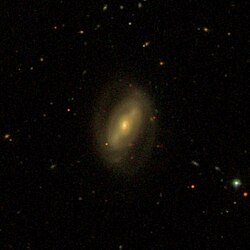NGC 4003
| NGC 4003 | |
|---|---|
 SDSS image of NGC 4003. | |
| Observation data (J2000 epoch) | |
| Constellation | Leo |
| Right ascension | 11h 57m 59.0s[1] |
| Declination | 23° 07′ 30″[1] |
| Redshift | 0.021848[1] |
| Heliocentric radial velocity | 6550 km/s[1] |
| Distance | 305 Mly (93.6 Mpc)[1] |
| Apparent magnitude (V) | 14.28[1] |
| Absolute magnitude (B) | -22.89[1] |
| Characteristics | |
| Type | SB0[1] |
| Mass | 4.8 × 1010[2] M☉ |
| Size | ~183,100 ly (56.13 kpc) (estimated)[1] |
| Apparent size (V) | 1.5′ × 0.9′[1] |
| Other designations | |
| UGC 06948, CGCG 127-115, MCG +04-28-105, PGC 037646[1] | |
NGC 4003 is a barred lenticular galaxy located 305 million light-years away[3] in the constellation Leo. It was discovered on April 10, 1785, by astronomer William Herschel.[4] NGC 4003 forms a pair with the galaxy NGC 4002 known as [T2015] nest 102886,[5] and is part of the Coma Supercluster.[6]
NGC 4003 has a triple-ringed structure. It has a nucleus with a ringlike structure with dust lanes inside it, a strong bar surrounded by a second ring which is connected to broad spiral arms, and a nearly complete outer ring. It is thought the structure of NGC 4003 is a result of past interaction with NGC 4002.[4]
NGC 4003 is a LINER galaxy,[7][8] with star formation dominating its nucleus,[7] and is host to a supermassive black hole with an estimated mass of 9.6 × 108 M☉.[9]
See also
[edit]References
[edit]- ^ a b c d e f g h i j k "Results for object NGC 4003". NASA/IPAC Extragalactic Database. NASA and Caltech. Retrieved 2025-07-07.
- ^ Aquino-Ortíz, E.; Valenzuela, O.; Sánchez, S. F.; Hernández-Toledo, H.; Ávila-Reese, V.; van de Ven, G.; Rodríguez-Puebla, A.; Zhu, L.; Mancillas, B.; Cano-Díaz, M.; García-Benito, R. (September 2018). "Kinematic scaling relations of CALIFA galaxies: A dynamical mass proxy for galaxies across the Hubble sequence". Monthly Notices of the Royal Astronomical Society. 479 (2): 2133–2146. arXiv:1806.09013. Bibcode:2018MNRAS.479.2133A. doi:10.1093/mnras/sty1522. ISSN 0035-8711.
- ^ "Your NED Search Results". ned.ipac.caltech.edu. Retrieved 2025-07-07.
- ^ a b "New General Catalog Objects: NGC 4000 - 4049". cseligman.com. Retrieved 2025-07-07.
- ^ Tully, R. Brent (2015-04-28). "Galaxy Groups: A 2Mass Catalog". The Astronomical Journal. 149 (5): 171. arXiv:1503.03134. Bibcode:2015AJ....149..171T. doi:10.1088/0004-6256/149/5/171. ISSN 1538-3881.
- ^ Gregory, S. A.; Thompson, L. A. (1978-06-15). "The Coma/A1367 supercluster and its environs". The Astrophysical Journal. 222: 784. Bibcode:1978ApJ...222..784G. doi:10.1086/156198. ISSN 0004-637X.
- ^ a b Gomes, J. M.; Papaderos, P.; Kehrig, C.; Vílchez, J. M.; Lehnert, M. D.; Sánchez, S. F.; Ziegler, B.; Breda, I.; Dos Reis, S. N.; Iglesias-Páramo, J.; Bland-Hawthorn, J.; Galbany, L.; Bomans, D. J.; Rosales-Ortega, F. F.; Cid Fernandes, R. (April 2016). "Warm ionized gas in CALIFA early-type galaxies. 2D emission-line patterns and kinematics for 32 galaxies". Astronomy and Astrophysics. 588: A68. arXiv:1511.02191. Bibcode:2016A&A...588A..68G. doi:10.1051/0004-6361/201525976. ISSN 0004-6361.
- ^ "ngc 4003". simbad.cds.unistra.fr. Retrieved 2025-07-07.
- ^ Arzoumanian, Zaven; Baker, Paul T.; Brazier, Adam; Brook, Paul R.; Burke-Spolaor, Sarah; Becsy, Bence; Charisi, Maria; Chatterjee, Shami; Cordes, James M.; Cornish, Neil J.; Crawford, Fronefield; Cromartie, H. Thankful; Decesar, Megan E.; Demorest, Paul B.; Dolch, Timothy (2021-06-01). "The NANOGrav 11 yr Data Set: Limits on Supermassive Black Hole Binaries in Galaxies within 500 Mpc". The Astrophysical Journal. 914 (2): 121. arXiv:2101.02716. Bibcode:2021ApJ...914..121A. doi:10.3847/1538-4357/abfcd3. ISSN 0004-637X.
